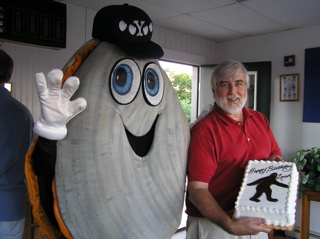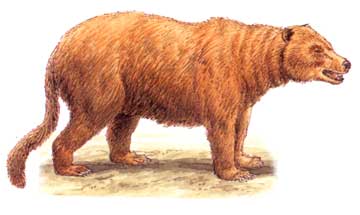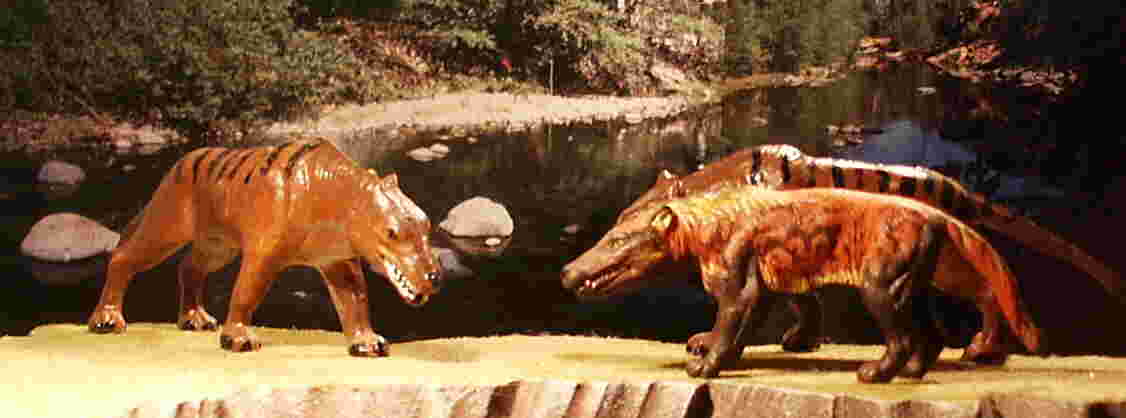
July 12, 2010

Andrewsarchus for the 12th? What is Loren talking about?
Even a hard-working cryptozoologist needs to take a break for his birthday, correct?
Here is a snapshot from my July 12th celebration in 2007, at the Portland Sea Dogs game:


The cake’s Sasquatch appears to be reaching out for a party favor given out during the party, which were copies of Tom Slick: True Life Encounters in Cryptozoology for each guest.
I always enjoy cryptid replicas, figurines and artifacts for the museum.
One gift that came in for 2009 was the Bullyland Andrewsarchus, which thus nearly completed my collection of these mammals. It is pictured in the top left hand corner on the “mountain” below, and at the top, the long animal in the foreground.
What do we know about Andrewsarchus and why are they so special?

In doing online research on the species Andrewsarchus mongoliensis, I came across the above John Sibbick’s painting ~ referenced and embedded by Wikipedia. According to the Wikipedia caption, the illustration shows the creodont Sarkastodon in the background, waiting for Andrewsarchus to finish feeding on the carcass of a recently deceased Embolotherium. The dead brontothere shown would have been about the size of a modern rhinoceros. A primate can be seen on a tree branch, and an early member of Carnivora, which eventually became the dominant land predators, is seen in the foreground.

The top image is extracted from a larger painting which can be found at Sibbick’s online gallery.
I direct your attention to the depiction of Sibbick’s Sarkastodon, said to be in the background, which has a strange look to it, as if his Sarkastodon is more like a character out of Alice In Wonderland.

Do you see the Cheshire Cat in Sibbick’s imagery?

The “hidden” nature of the Cheshire Cat (here below seen “fading away”) is rather cryptic.

Other illustrative drawings of Sarkastodon, as in these two following examples, show a slightly different creature. I wonder if the animal in the foreground of Siddick’s larger picture is a Sarkastodon?


As to Andrewsarchus, there are different replica representations, of course.

The Bullyland Andrewsarchus (above) is rare.

The Safara, Ltd. Andrewsarchus (above) is the easiest to obtain.

The striped Starlux replica (left) and the Kaiydo Dino Tales Andrewsarchus (right) are often difficult to find. I do not own the Starlux one, and it is missing from my collection.
Some replica images are from Dinosaur Collector’s Paleocene-Eocene diorama pages.

Andrewsarchus was, conservatively, 11 feet long from snout to the back without the tail, but 13-18 feet in some estimates and 6 feet tall at the shoulders. It is the world’s largest mammalian carnivore to have ever lived. It was a basal, heavily-built, wolf-like mammal that lived during the Eocene epoch, roughly between 45 and 36 million years ago. It walked on four short legs and had a long body, a long tail, and may have had feet with hoofed toes. It is only known from one skull and a few bones.
Besides the fact it is an intriguing and attractive replica of an extinct mammal, another reason I like this piece is that the Andrewsarchus is named for the famous explorer, fossil hunter, and cryptozoologist Roy Chapman Andrews. (For one cryptolink, see Chad Arment’s excellent edition of Harry R. Caldwell’s Blue Tiger, which has an additional appendix, where Roy Chapman Andrews describes his point-of-view of the search for the cryptid melanistic feline.)
Andrewsarchus was discovered in June 1923 by Kan Chuen Pao, a member of Andrews’ expedition, on a site in the Gobi Desert in Mongolia known as Irdin Mahna (“Jeweled Mandala”) on the third Asiatic expedition that was led by Andrews and sponsored by the American Museum of Natural History. In 1922, Andrew’s party had discovered a fossil of Indricotherium (then named Baluchitherium), a gigantic hornless rhinoceros.
In the past, I was still in search of a replica of the Deinotherium and the “display mountain” for my Bullyland “prehistoric mammals” collection. As you can see at the top, Darren Naish has this relative of the elephant in his gathering of replicas. I have since obtained this special elephant, but not the actual Bullyland mountain. That may take a few years.

Deinotherium from Bullyland.
If you wish to celebrate my birthday in a supportive and appreciative fashion by donating to the International Cryptozoology Museum, please click on the button below.
Thus please…join the effort to preserve cryptozoology history, do your part and donate today:

Thank you!
About Loren Coleman
Loren Coleman is one of the world’s leading cryptozoologists, some say “the” leading living cryptozoologist. Certainly, he is acknowledged as the current living American researcher and writer who has most popularized cryptozoology in the late 20th and early 21st centuries.
Starting his fieldwork and investigations in 1960, after traveling and trekking extensively in pursuit of cryptozoological mysteries, Coleman began writing to share his experiences in 1969. An honorary member of Ivan T. Sanderson’s Society for the Investigation of the Unexplained in the 1970s, Coleman has been bestowed with similar honorary memberships of the North Idaho College Cryptozoology Club in 1983, and in subsequent years, that of the British Columbia Scientific Cryptozoology Club, CryptoSafari International, and other international organizations. He was also a Life Member and Benefactor of the International Society of Cryptozoology (now-defunct).
Loren Coleman’s daily blog, as a member of the Cryptomundo Team, served as an ongoing avenue of communication for the ever-growing body of cryptozoo news from 2005 through 2013. He returned as an infrequent contributor beginning Halloween week of 2015.
Coleman is the founder in 2003, and current director of the International Cryptozoology Museum in Portland, Maine.
Filed under Cryptomundo Exclusive, Cryptotourism, CryptoZoo News, Cryptozoologists, Cryptozoology, Expedition Reports, Fossil Finds, Megafauna, Men in Cryptozoology, Replica Cryptia